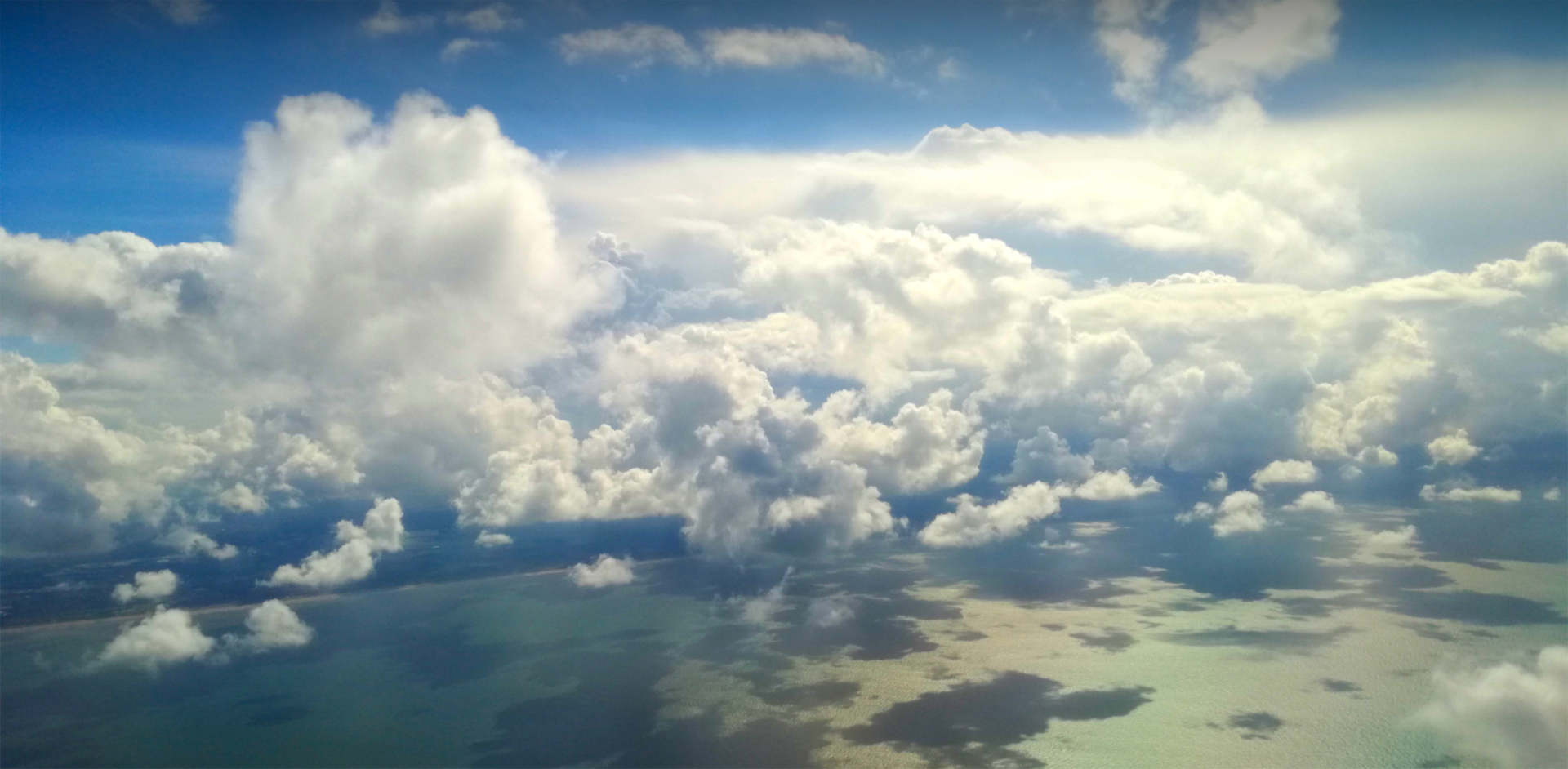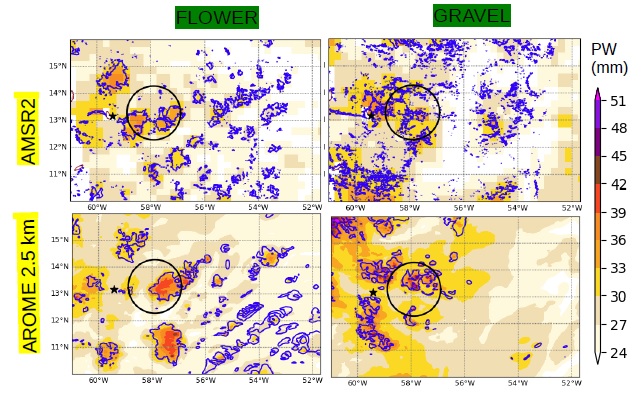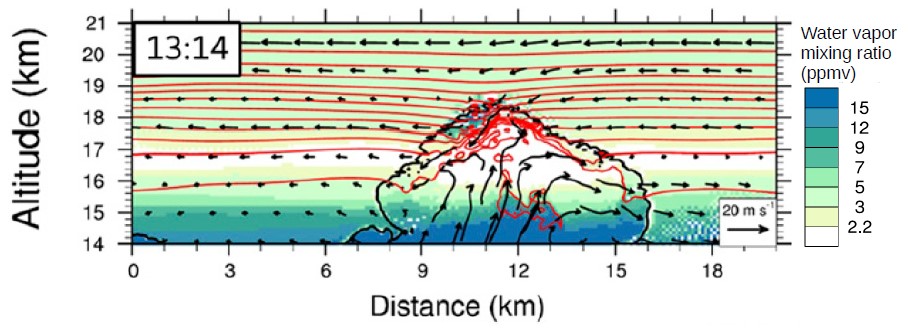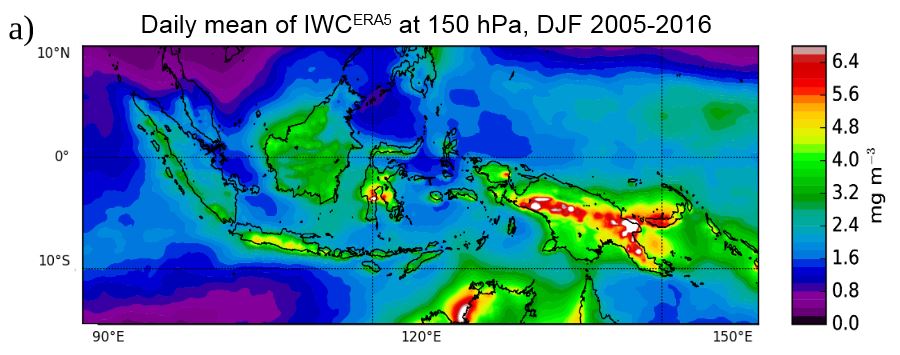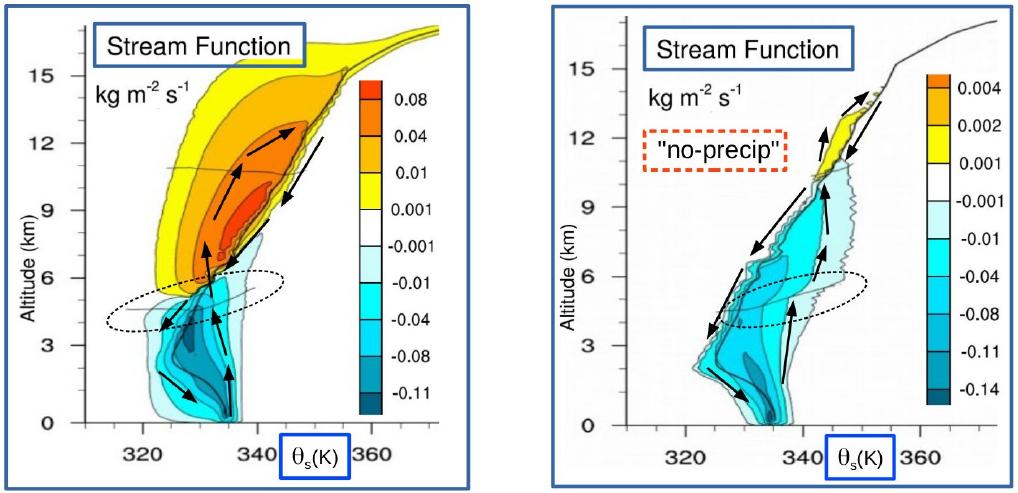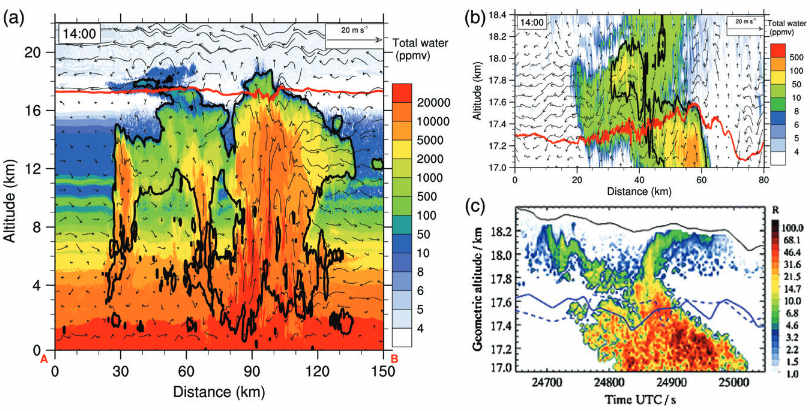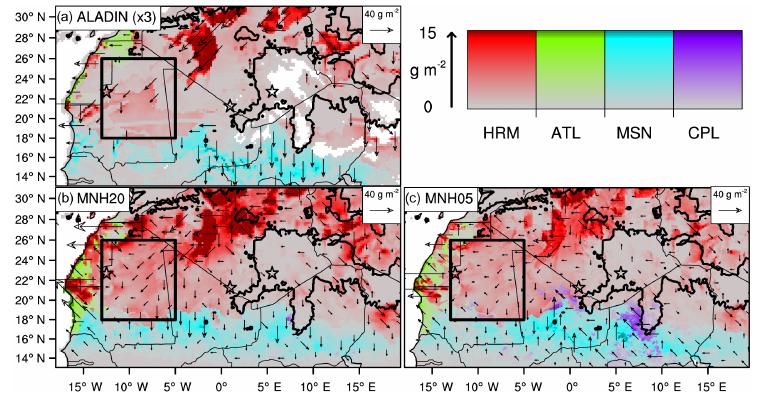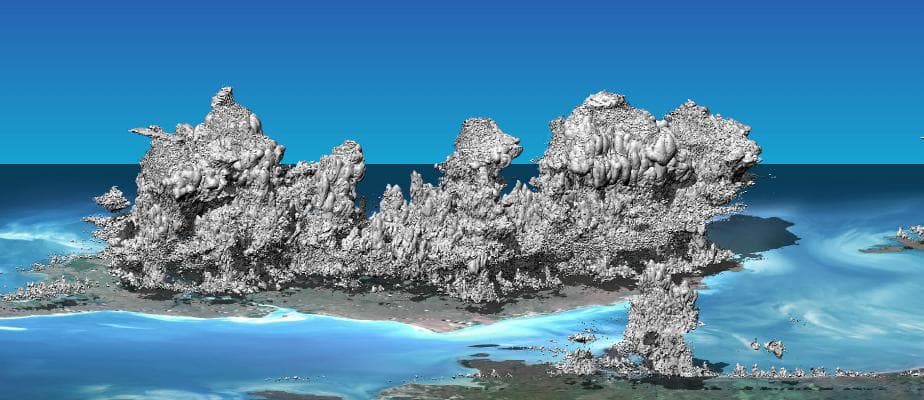The Flower trade-wind clouds are shallow mesoscale convective systems
The Flower trade-wind clouds are shallow mesoscale convective systems
Thibaut Dauhut, Fleur Couvreux, Dominique Bouniol, Florent Beucher, Lea Volkmer, Veronika Pörtge, Michael Schäfer, Alex Ayet, Pierre-Etienne Brilouet, Marek Jacob and Martin Wirth
Published on 28 November 2022
The 3D-rendering topview image of the Flower trade-wind cloud has been made by N. Villefranque using her Htrdr ray-tracer algorithm and the LES (dx=100m) output after 4 hours of simulation.
Process-oriented evaluation of the oversea AROME configuration: Focus on the representation of cloud organisation
Process Oriented evaluation of the oversea AROME configuration: focus on the representation of cloud organisation
Florent Beucher, Fleur Couvreux, Dominique Bouniol, Ghislain Faure, Florence Favot, Thibaut Dauhut and Alex Ayet
Published on 05 August 2022
Short description in preparation.
The contribution of convection to the stratospheric water vapour: the first budget using a Global Storm-Resolving Model
The contribution of convection to the stratospheric water vapour: the first budget using a Global Storm-Resolving Model
Thibaut Dauhut and Cathy Hohenegger
Published on 21 February 2022
Short description in preparation.
EUREC4A
EUREC4A
Bjorn Stevens and 292 co-authors including Thibaut Dauhut
Published on 25 August 2021
I took part in the EUREC4A field campaign. I was onboard the Research Vessel L'Atalante. We chase the largest gradients of sea surface temperature in the region of Boulevard des Tourbillons in order to investigate their role in the coupling between the ocean and the atmosphere. I was responsible for 4 remote-sensing instruments onboard and co-responsible for the launches of radiosondings. The remote-sensing instruments are one visible and one infra-red cloud cameras, a ceilometer and a manual sunphotometer. Two radiosounding strategies were led. (1) Regular Vaisala launches, every 4 hours, up to the burst altitude and back down, in order to document the environment in which the clouds develop. (2) Intensive launches, one every 45 min in average, up to about 10 km, in order to sample at higher frequency the lower atmosphere in few regions targeted for their strong gradients in sea surface temperature.
The mechanisms leading to a stratospheric hydration by overshooting convection
The mechanisms leading to a stratospheric hydration by overshooting convection
Thibaut Dauhut, Jean-Pierre Chaboureau, Peter H. Haynes and Todd P. Lane
Published on 18 February 2021
Overshoots are convective air parcels that rise beyond their level of neutral buoyancy. Based on the Giga-LES of “Hector the Convector” (100-m cubic resolution), I used the clustering algorithm that I developed (cf. Dauhut et al., 2016) to identify the overshoots of the very deep convective system. I made further development to be able to track them in time. In this study I consider the 46 overshoots that I was able to track over more than 10 min. Hydration of the stratosphere occurs through a sequence of mechanisms: overshoot penetration into the stratosphere, followed by entrainment of stratospheric air and then by efficient turbulent mixing between the air in the overshoot and the entrained warmer air, leaving the subsequent mixed air at about the maximum overshooting altitude. The time scale of these mechanisms is about 1 min. The maximum overshooting altitude is key to determine whether or not the overshoots hydrate the stratosphere and by how much they do.
Ship and island-based atmospheric soundings from the 2020 EURECA field campaign
Ship and island-based atmospheric soundings from the 2020 EURECA field campaign
Claudia C. Stephan, Sabrina Schnitt, Hauke Schulz, Hugo Bellenger, Simon P. de Szoeke, Claudia Acquistapace, Katharina Baier, Thibaut Dauhut and 28 other co-authors
Published on 18 February 2021
I was part of the EUREC4A field campaign (January-February 2020). One of my task on board the Atalante research vessel was to be responsible for the launches of the atmospheric radio-soundings.
Ice injected into the tropopause by deep convection – Part 2: Overthe Maritime Continent
Ice injected into the tropopause by deep convection – Part 2: Overthe Maritime Continent
Iris-Amata Dion, Cyrille Dallet, Philippe Ricaud, Fabien Carminati, Peter Haynes and Thibaut Dauhut
Published on 15 February 2021
The amount of ice injected up to the tropical tropopause layer has a strong radiative impact on climate. In the tropics, the Maritime Continent (MariCont) region presents the largest injection of ice by deep convection into the upper troposphere (UT) and tropopause level (TL) (from results presented in the companion paper Part 1). This study focuses on the MariCont region and aims to assess the processes, the areas and the diurnal amount and duration of ice injected by deep convection over islands and over seas using a 2◦×2◦ horizontal resolution during the austral convective season of December, January and February.
Simulated tropical precipitation assessed across three major physes of the Coupled Model Intercomparion Project (CMIP)
Simulated tropical precipitation assessed across three major physes of the Coupled Model Intercomparion Project (CMIP)
Stephanie Fiedler, Traute Crueger, Roberta D'Agostino, Karsten Peters, Tobias Becker, David Leutwyler, Laura Paccini, Jörg Burdanowitz, Stefan A Buehler, Alejandro Uribe, Thibaut Dauhut, Dietmar Dommenget, Klaus Fraedrich, Leonore Jungandreas, Nicola Maher, Ann Kristin Naumann, Maria Rugenstein, Mirjana Sakradzija, Hauke Schmidt, Frank Sielmann, Claudia C Stephan, Claudia Timmreck, Xiuhua Zhu, Bjorn Stevens
Published on 20 August 2020
The representation of tropical precipitation is evaluated across three generations of models participating in phases 3, 5, and 6 of the Coupled Model Intercomparison Project (CMIP). Compared to state-of-the-art observations, improvements in tropical precipitation in the CMIP6 models are identified for some metrics, but we find no general improvement in tropical precipitation on different temporal and spatial scales. Our results indicate overall little changes across the CMIP phases for the summer monsoons, the double-ITCZ bias, and the diurnal cycle of tropical precipitation. We find a reduced amount of drizzle events in CMIP6, but tropical precipitation occurs still too frequently. Continuous improvements across the CMIP phases are identified for the number of consecutive dry days, for the representation of modes of variability, namely, the Madden–Julian oscillation and El Niño–Southern Oscillation, and for the trends in dry months in the twentieth century. The observed positive trend in extreme wet months is, however, not captured by any of the CMIP phases, which simulate negative trends for extremely wet months in the twentieth century. The regional biases are larger than a climate change signal one hopes to use the models to identify. Given the pace of climate change as compared to the pace of model improvements to simulate tropical precipitation, we question the past strategy of the development of the present class of global climate models as the mainstay of the scientific response to climate change. We suggest the exploration of alternative approaches such as high-resolution storm-resolving models that can offer better prospects to inform us about how tropical precipitation might change with anthropogenic warming.
The diurnal cycle of the clouds extending above the tropical tropopause observed by spaceborne lidar
The diurnal cycle of the clouds extending above the tropical tropopause observed by spaceborne lidar
Thibaut Dauhut, Vincent Noel and Iris-Amata Dion
Published on 1 April 2020
The presence of clouds above the tropopause over tropical convection centers has so far been documented by spaceborne instruments that are either sun-synchronous or insensitive to thin cloud layers. Here we document, for the first time through direct observation by spaceborne lidar, how the tropical cloud fraction evolves above the tropopause throughout the day. After confirming previous studies that found such clouds most frequently above convection centers, we show that stratospheric clouds and their vertical extent above the tropopause follow a diurnal rhythm linked to convective activity. The diurnal cycle of the stratospheric clouds displays two maxima: one in the early night (19:00–20:00 LT) and a later one (00:00–01:00 LT). Stratospheric clouds extend up to 0.5–1 km above the tropopause during nighttime, when they are the most frequent. The frequency and the vertical extent of stratospheric clouds is very limited during daytime, and when present they are found very close to the tropopause. Results are similar over the major convection centers (Africa, South America and the Warm Pool), with more clouds above land in DJF (December–January–February) and less above the ocean and in JJA (June–July–August).
Convective hydration in the tropical tropopause layer during the StratoClim aircraft campaign: pathway of an observed hydration patch
Convective hydration in the tropical tropopause layer during the StratoClim aircraft campaign: pathway of an observed hydration patch
Keun-Ok Lee, Thibaut Dauhut, Jean-Pierre Chaboureau, Sergey Khaykin, Martina Krämer and Christian Rolf
Published on 24 September 2019
The source and pathway of the hydration patch in the TTL (Tropical Tropopause Layer) that was measured during the StratoClim field campaign during the Asian summer monsoon in 2017, and its connection to convective overshoots are investigated.
Ice injected up to the Tropopause by Deep Convection - Part 1: In the Austral Convective Tropics
Ice injected up to the Tropopause by Deep Convection - Part 1: In the Austral Convective Tropics
Iris-Amata Dion, Philippe Ricaud, Peter Haynes, Fabien Carminati and Thibaut Dauhut
In discussion
The impact of deep convection on the water budget (water vapor and ice) from the tropical Upper Troposphere(UT, around 146 hPa) to the Tropopause Level (TL, around 100 hPa) is investigated. Ice water content (IWC) and watervapour (WV) measured in the UT and the TL by the Microwave Limb Sounder (MLS, Version 4.2) are compared to theprecipitation (Prec) measured by the Tropical Rainfall Measurement Mission (TRMM, Version 007).
The Three Atmospheric Circulations over the Indian Ocean and the MaritimeContinent and Their Modulation by the Passage of the MJO
The Three Atmospheric Circulations over the Indian Ocean and the MaritimeContinent and Their Modulation by the Passage of the MJO
Daria Kuznetsova, Thibaut Dauhut and Jean-Pierre Chaboureau
Published on 28 November 2018
The passage of the Madden–Julian oscillation (MJO) over the Indian Ocean and the Maritime Continentis investigated during the episode of 23–30 November 2011. A Meso-NH convection-permitting simulationwith a horizontal grid spacing of 4 km is examined. The simulation reproduces the MJO signal correctly, showingthe eastward propagation of the primary rain activity.
A Third-Law Isentropic Analysis of a Simulated Hurricane
Reply to the Comments of Olivier Pauluis to the paper “A Third-Law Isentropic Analysis of a Simulated Hurricane”
Pascal Marquet and Thibaut Dauhut
Published on 10 August 2018
Detailed investigation of the moist-air entropy and its meaning for the atmospheric systems like the deep convective systems. The use of theta_s as a strict equivalent of the entropy is illustrated with the isentropic diagrams of Hector the Convector.
Giga-LES of Hector the Convector and Its Two Tallest Updrafts up to the Stratosphere
Giga-LES of Hector the Convector and Its Two Tallest Updrafts up to the Stratosphere
Thibaut Dauhut, Jean-Pierre Chaboureau, Juan Escobar and Patrick Mascart
Published on 7 December 2016
The updrafts inside Hector are identified using a clustering algorithm, that I developed to run on parallel supercomputers. Within more than 16 000 updrafts with vertical velocities larger than 10 m/s, only a dozen are 4-km tall. The two tallest only crontribute to more than 90% of the vertical mass flux across the tropical tropopause layer (TTL) and produce overshoots into the stratosphere.
The Atmospheric Overturning Induced by Hector the Convector
The Atmospheric Overturning Induced by Hector the Convector
Thibaut Dauhut, Jean-Pierre Chaboureau, Patrick Mascart and Olivier Paulius
Published on 20 September 2017
The overturning of Hector the Convector, a tropical multicellular convective system of northern Australia that regularly overshoots into the stratosphere, is synthesized at the scale of a large-eddy simulation. The isentropic analysis offers the advantage of filtering out the reversible motions due to gravity waves and taking into account the turbulent fluxes that contribute to the vertical transport. Two key circulations are charac- terized: the troposphere deep overturning and the mass exchange due to the overshoots into the stratosphere. The transition from deep to very deep convection is associated with a change in the diabatic tendency inside the tallest updrafts: the latent heat release due to the formation of a large amount of icy hydrometeors exceeds the loss of energy due to mixing with the drier, colder air of the environment.
Large-eddy simulations of Hector the convector making the stratosphere wetter
Large-eddy simulations of Hector the convector making the stratosphere wetter
Thibaut Dauhut, Jean-Pierre Chaboureau, Juan Escobar and Patrick Mascart
Published on 12 September 2014
A series of large-eddy simulations (LES) were performed for a Hector thunderstorm observed on 30 November 2005 over the Tiwi Islands. On that day, ice particles reaching 19-km altitude were measured. The LES developed overshooting updrafts penetrating the stratosphere that compared well with observations. While moistening appeared to be robust with respect to the grid spacing used, grid spacing on the order of 100 m may be necessary for a reliable estimate of hydration.
Near-inertial motions in the Brazil Current at 24°S-36°S: Observations by satellite tracked drifters
Near-inertial motions in the Brazil Current at 24°S-36°S: Observations by satellite tracked drifters
Arcilan T. Assireu, Thibaut Dauhut, Francisco A. dos Santos and João A. Lorenzzetti
Published on 12 July 2017
I did a one-year intership at the research institute for the natural ressources of the Federal University of Itajuba, Brazil.
During this period I characterised the near inertial currents (NICs) in the ocean and their link with the synoptic weather conditions.
All my results are presented in this study. I used the trajectories from drifters to examine motions in the inertial frequency band. The atmospheric conditions were favorable to NICs generations: the wind stress rotary spectrum is anticyclonically polarized with a near-inertial peak.
In the ocean, a large increase in the eddy kinetic energy is found in the f band south of 28°S. The predominance of NICs south of 28°S appears to be related to the Effective Coriolis Frequency.
Fennec dust forecast intercomparison over the Sahara in June 2011
Fennec dust forecast intercomparison over the Sahara in June 2011
Jean-Pierre Chaboureau, Cyrille Flamant, Thibaut Dauhut, Cécile Kocha, Jean-Philippe Lafore, Chistophe Lavaysse, Fabien Marnas, Mohamed Mokhtari, Jacques Pelon, Irene Reinares Martínez, Kerstin Schepanski, and Pierre Tulet
Published on 7 June 2016
The clustering algorithm, that I developed to run on parallel computers, can be used to identify any 2-D or 3-D meteorological strucutre. Here a nice example with the identification of the wind regimes over Africa, that latter lead to dust emission. Beside the harmattan (HRM), the cold pools (CPL) below some convective systems contribute to the observed large near-surface dust concentrations.
Overview of the Meso-NH model version 5.4 and its applications
Overview of the Meso-NH model version 5.4 and its applications
Christine Lac and co-authors
Published on 29 May 2018
The reference description of the tool I use to produce simulations: the non-hydrostatic atmospheric model Meso-NH.
